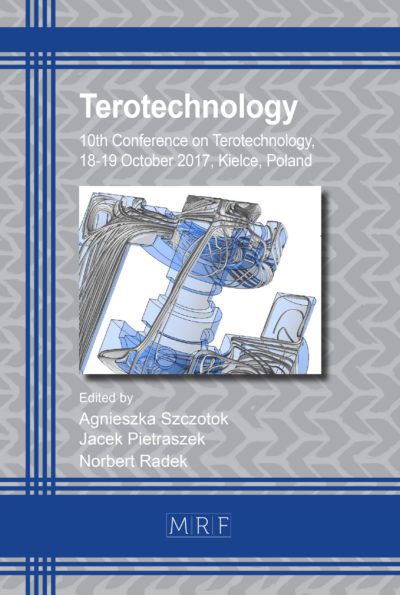Parameter identification for deep rolling of X120Mn12+VC deposition layer
Murli Manohar PANDEY, Erik FORKE, Stefan SCHUBERTH, Toni SPRIGODE, Till CLAUSMEYER, Guntram WAGNER
Abstract. The machine parts subjected to high wear are conventionally thermally hardened and/or hard coated to minimize surface erosion. The hard coating requires special arrangements and complex machining and finishing processes, which are time and labor-intensive. An alternative solution is work hardening of the surfaces, where hardening and surface finishing can be achieved within a single process step. The manganese steel X120Mn12 is known for its excellent work hardening and wear resistance, making it suitable for applications that require superior surface properties. The addition of 15 wt.% vanadium carbide (VC) enhances its abrasion resistance. Deep rolling (DR) processes have been found to affect microtopography, including surface roughness, increase hardness, and induce compressive residual stresses. Within the scope of this paper, a layer X120Mn12+VC is PTA (Plasma-transferred arc) welded onto a S235 steel substrate. The samples are then deep rolled under various combinations of influencing parameters such as rolling pressure, tool diameter, and feed. The main focus was to achieve maximum surface hardness, an optimal hardness depth profile, and reduced surface roughness. The combination of optimal deep rolling parameters achieved the surface hardness of 640 HV 1 while maintaining a relatively smooth surface. Additionally, an FE model was built, and the optimal DR process was simulated to study the development of residual stresses. The local distribution of equivalent plastic stresses corresponds well with the measured hardness distribution.
Keywords
Manganese Steel, Vanadium Carbide, PTA, Work Hardening, Deep Rolling, Surface Hardness, FEM
Published online 5/7/2025, 10 pages
Copyright © 2025 by the author(s)
Published under license by Materials Research Forum LLC., Millersville PA, USA
Citation: Murli Manohar PANDEY, Erik FORKE, Stefan SCHUBERTH, Toni SPRIGODE, Till CLAUSMEYER, Guntram WAGNER, Parameter identification for deep rolling of X120Mn12+VC deposition layer, Materials Research Proceedings, Vol. 54, pp 2183-2192, 2025
DOI: https://doi.org/10.21741/9781644903599-235
The article was published as article 235 of the book Material Forming
![]() Content from this work may be used under the terms of the Creative Commons Attribution 3.0 license. Any further distribution of this work must maintain attribution to the author(s) and the title of the work, journal citation and DOI.
Content from this work may be used under the terms of the Creative Commons Attribution 3.0 license. Any further distribution of this work must maintain attribution to the author(s) and the title of the work, journal citation and DOI.
References
[1] E. Brinksmeier, M. Garbrecht, D. Meyer, and J. Dong, Surface hardening by strain induced martensitic transformation, J. Prod. Eng. 2 (2008) 109–116. https://doi.org/10.1007/s11740-007-0060-6
[2] A. Rodríguez, L. N. L. De Lacalle, A. Celaya, A. Lamikiz, and J. Albizuri, Surface improvement of shafts by the deep ball-burnishing technique, J. Surf. Coat. Tech. 206, no. 11–12 (2012) 2817–2824. https://doi.org/10.1016/j.surfcoat.2011.11.045
[3] P. Groche, M. Engels, M. Steitz, C. Müller, J. Scheil, and M. Heilmaier, Potential of mechanical surface treatment for mould and die production, Int. J. Mater. Res. 103, no. 6 (2012) 783–789. https://doi.org/10.3139/146.110778
[4] H.-W. Zoch and G. Spur, Handbuch Wärmebehandeln und Beschichten, Carl Hanser Verlag, 2015. https://doi.org/10.1007/978-3-446-43003-7
[5] V. Llaneza and F. J. Belzunce, Study of the effects produced by shot peening on the surface of quenched and tempered steels: roughness, residual stresses and work hardening, J. Appl. Surf. Sci. 356, (2015) 475–485. https://doi.org/10.1016/j.apsusc.2015.08.110
[6] D. Meyer and J. Kämmler, Surface Integrity of AISI 4140 After Deep Rolling with Varied External and Internal Loads, Procedia CIRP 45 (2016) 363–366. https://doi.org/10.1016/j.procir.2016.02.356
[7] B. Denkena, T. Grove, B. Breidenstein, A. Abrão, and K. Meyer, Correlation between process load and deep rolling induced residual stress profiles, Procedia CIRP 78 (2018) 161–165. https://doi.org/10.1016/j.procir.2018.09.063
[8] A. M. Abrão, B. Denkena, J. Köhler, B. Breidenstein, and T. Mörke, The Influence of Deep Rolling on the Surface Integrity of AISI 1060 High Carbon Steel, Procedia CIRP 13 (2014) 31–36. https://doi.org/10.1016/j.procir.2014.04.006
[9] M. Hettig and D. Meyer, Microstructural influence of consecutive deep rolling of AISI 4140, Procedia CIRP 108 (2022) 164–169. https://doi.org/10.1016/j.procir.2022.03.029
[10] S. Schuberth, S. Weis, T. Uhlig, G. Wagner, and B. Wielage, Development of alloys with high impact and abrasion resistance for wear-resistant weld overlay, Welding and cutting 15 (2016), 184-187.
[11] R. Harzallah, A. Mouftiez, E. Felder, S. Hariri, and J. -p. Maujean, Rolling contact fatigue of Hadfield steel X120Mn12, Wear 269, no. 9–10 (2010) 647–654. https://doi.org/10.1016/j.wear.2010.07.001
[12] A. Lim, S. Castagne, and C. C. Wong, Effect of Deep Cold Rolling on Residual Stress Distributions Between the Treated and Untreated Regions on Ti–6Al–4V Alloy, J. Manuf. Sci. Eng 138, no. 11(2016) 111005, https://doi.org/10.1115/1.4033524













